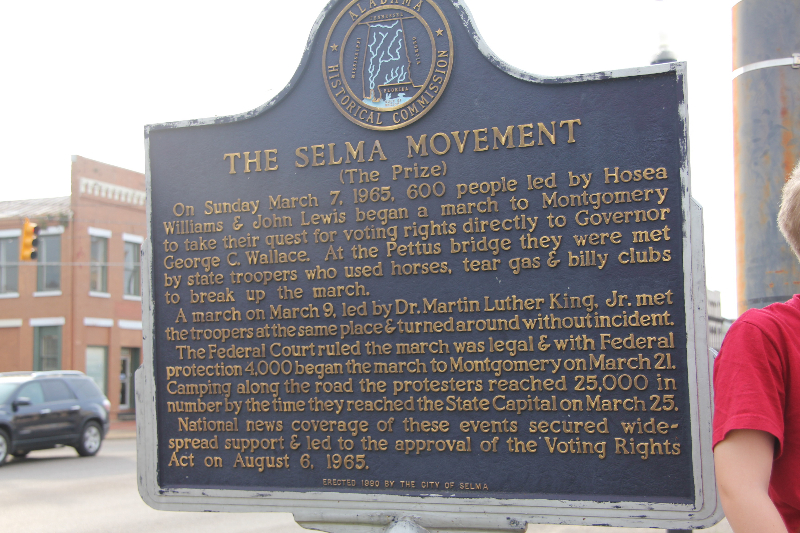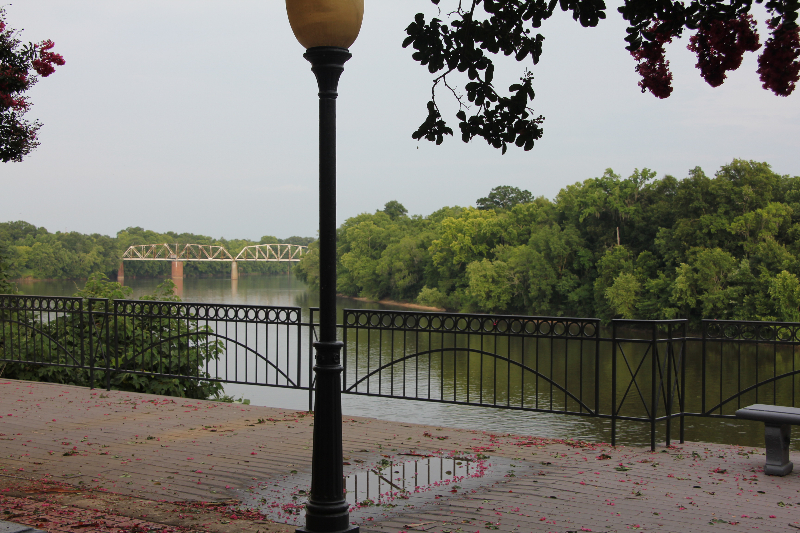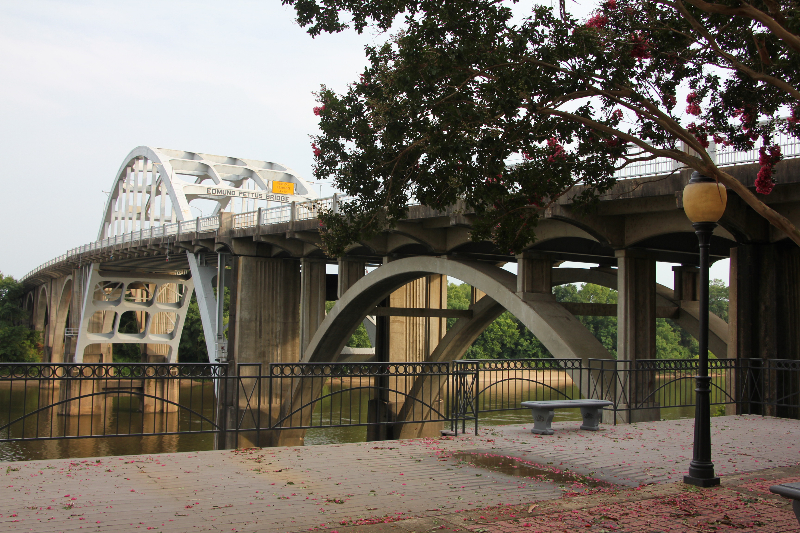Growing up, I only learned the “standard” stuff about the Civil Rights movement. Pretty much just what was in my Texas-state-adopted-history textbooks, which means that I missed a lot. It wasn’t until I began working on my Ph.D. in curriculum and instruction, in 2000, and started digging into the history of school desegregation in Baton Rouge, that I became aware of just how large the hole in my knowledge was.
So I began working on filling it. I assume this will be a lifelong endeavor and one that I never anticipate being able to say I have completed.
Ever since I read Georgia Congressman John Lewis’s amazing memoir, Walking with the Wind (I cannot recommend this book more enthusiastically), I have wanted to go see the Edmund Pettus Bridge in Selma, Alabama–along with numerous other noteworthy places significant to the Civil Rights movement. I felt like I just had to see this place where approximately 25,000 people marched to draw attention to the issue of racial inequality and discrimination in our country. 25,000 people. That’s almost as many people as live in my entire town.
This summer, as we were planning a big college tour road trip, I happened to notice that if we went a certain way, driving through Selma was only a little bit out of our way. That was it. This was my chance.
As we approached Selma in late June 2013, I started reading some things to the kids about John Lewis and about the events leading up to the Selma to Montgomery March in 1965. I felt a little bit like a pilgrim, on a hajj. Once we got there, we got out of the car and walked around. We had our usual combination of good moments and annoying ones that included fighting, bickering, whining, inexplicable reluctance to get out of the car, not being able to find one’s shoes, etc. But mostly it was awesome.
It felt like sacred ground to me (thus my inclusion of the slideshow here as part of the Ride to Church series). In part, I wished I had had the opportunity to just sit and be in that space, quietly, for a while, but it wasn’t meant to be. Instead, I enjoyed having my kids there. As we were all piling back into the car, one of them (I can’t remember which one) said, “I’ll never forget coming here.” And I said, “Me, neither.”
Fast forward to September 2013. Lots of people in Mormon-internet-land (a.k.a. the “Bloggernacle”) are all abuzz about Ordain Women and the event that is taking place on Saturday, October 5. I have been involved in this group, but have been on the fence about going. Part of me has been wanting to go, of course, because gender inequality in the Mormon church has become an issue that I simply cannot abide. But part of me was thinking of sitting it out–watching the event unfold from the comfort of my backwoods East Texas home–mostly because I’ve grown weary of the issue. It’s just become too big and too bad and too depressing and, frankly, too hopeless. I’ve used up a lot of energy over the last 5 years, wringing my hands over it and contemplating the possibility of never being able to see any meaningful change come to pass during my lifetime (or possibly during my children’s lifetimes).
A couple weeks ago, I sent an email to my aunt, a very thoughtful no-longer-Mormon woman who sympathizes with much of my misfit-Mormon-angst. In the email, I shared with her some of my thoughts about going or not going and also included a link to the fundraising page. ;)
She sent this back to me:
“Dear Heather, whether you have 8 people or 83, you will be noticed. Look at how long it took to gain women’s suffrage. I’ll always regret that I had an opportunity to march at Selma and stayed home. So I tried to make up for it by marching against the Vietnam war and for the ERA, but still, there was Selma. Go and try to have your photo taken and post it on YouTube.
Go!”
There it was, again: Selma.
So I bought my ticket. I’ll be there with however many of us show up. I don’t know that I’ll be noticed, but I will notice it. And my kids will know I was there, trying to do as I learned as a Mormon girl:
Dare to do right, dare to be true.
You have a work that no other can do.
Do it so bravely, so kindly, so well
Angels will hasten the story to tell.
Dare, dare, dare to do right.
Dare, dare, dare to be true.
Dare to be true, dare to be true.
This feels right and true to me.
;

















Thank you for posting this and thank you for going. Can’t wait to see your October Ride to Church post ;-)
Fare well, Heather. Remember that the march to Selma didn’t end there.
So glad you are going!
Thanks, Heather, for standing for human rights, both on the Edmund Pettus Bridge and before the door of the Mormon tabernacle. When we marched in the 60’s, we would say, “Put your body on the line,” to show that we were willing to risk harm to ourselves for demonstrating against injustice. May no harm come to you, but realize your cause is just. Aunt Marilyn
I’m reading this with deep sadness. I am part black, though not visibly so. I’ve been trying to understand what happened. I admit to not liking Brigham Young. I have read so many accounts of slavery that have broken my heart. I am a woman. I know that women have been badly treated at times and in places. The ill treatment has not been as widespread, however, as was the institution of slavery. Yes black women had terrible things happen to them, but so did men.
The civil rights movement involved death and tragedy. And black people still find it difficult in a world that is predominated by white people.
I understand that many women in and out of the church, young and old, though mostly young, struggle with the inequality that exists in the church. I have seen that inequality, and it is inexcusable.
I know that it was wrong for Brigham Young (or whoever did it) to take away from the women the privilege of giving blessings, especially to children and other women. It seems that Brigham Young undid all the good things Joseph Smith did. That is wrong.
But I don’t want the “priesthood” as it is now constituted. I don’t want to sit in more meetings. I don’t want more power. I would be crunched as much by powerful women as I have been by men. Even now very few people, men and women, understand D&C 121 and truly repent of having unrighteous dominion, and I strongly believe that the priesthood is often used unrighteously. Why not just be righteous? I don’t want to be like the men. Too many of them are pompous and full of themselves. I have seen women who struggle with the same character weaknesses. Even now I have to endure some women in the church who are strident and oppressive and who boss and push. Those of us in the church who are weak will have even more people to defend ourselves against. Frankly, some of the LDS women I have met are more frightening to me than the men have been. I have been able to laugh at the men (behind their backs) for being insufferable. The worst supervisors in job settings that I ever had were women. Aggressive women will fight their ways forward, and the weak ones will just be weak. And suffer more. Just as civil rights were granted to “my” people after centuries of oppression and slavery, so the strong ones found a way to break their families and imprison them. Most black people in the inner cities are not healthy or happy. And it’s not because they don’t have “civil rights”. Civil rights mean nothing without universal human respect. Changing laws will never change hearts. I can think of several women (LDS) in my past who would take the priesthood and grind the weak ones down with it. How on earth will it be guaranteed that that will not happen. It is already happening with men. Amen to the priesthood and authority of that man, and yet the oppression continues.
If women are given the priesthood, I will, as one man in our ward has done, simply say, “no thank you”. I had a black ancestor who could pass for white, and he said, “no, thank you”. I guess my example is before me.
Must be anonymous for this,
Thank you for sharing your experiences and feelings. I appreciate so much your heartfelt expression. I hesitated to make a comparison to the Civil Rights movement because the analogy doesn’t work in many ways. Still, I think we can learn much from the experiences of African Americans and others who have fought (and continue to fight) those battles.
Your comments about the oppressive nature of power are on point and give me pause. I don’t personally want the priesthood, but I know there are women who do. And I want for them to be able to have it if they wish.
Finally, I so love your comments re: universal human respect. I also love Kate Kelly’s notion of wanting female ordination as an exercise in “radical self-respect.” See here: http://www.mormonwomen.com/2013/09/12/the-house-she-lives-in/
For me, this also feels like an exercise in learning to respect myself and ask that others respect me as well. Also, it’s important for me to teach my children to respect me and themselves.
Anyway, I’m blathering now. Just wanted to thank you for your message. It gives me some things to think about.
I had a similar experience recently – I went to the The Center in Las Vegas to view a movie about Baynard Rustin http://en.wikipedia.org/wiki/Bayard_Rustin That made me want to grab a poster and march to Washington DC or something drastic to bring to light immigration reform which is now drowned by other shaningens in Congress.
Brother Outsider. Watch it.
There were people in the audience at the LGBTQ Center where I viewed it – who knew Baynard Rustin.
Why is this important? Mormons are missing a whole “other” group and experiences. That movie was spiritual. The Lord had a work for Baynard to do.
To see and hear people like John Lewis or people who marched with Martin Luther King Jr or talk with someone who knew Baynarf Rustin – is eye opening and important.
Mormons do not have a corner on pioneers. We exclude ourselves from important work when we don’t advocate for everyone and ask for tolerance and Christlike treatment. We can ask. We should ask.